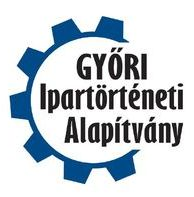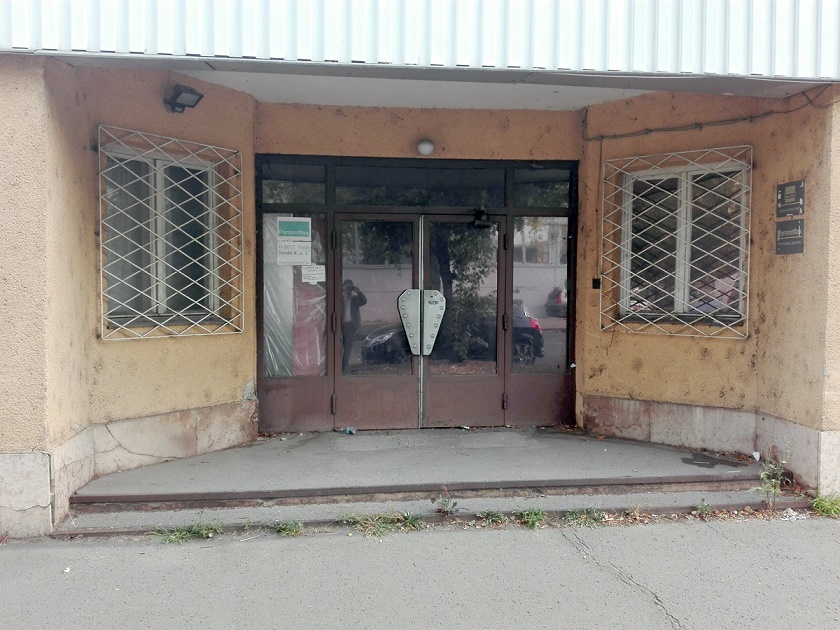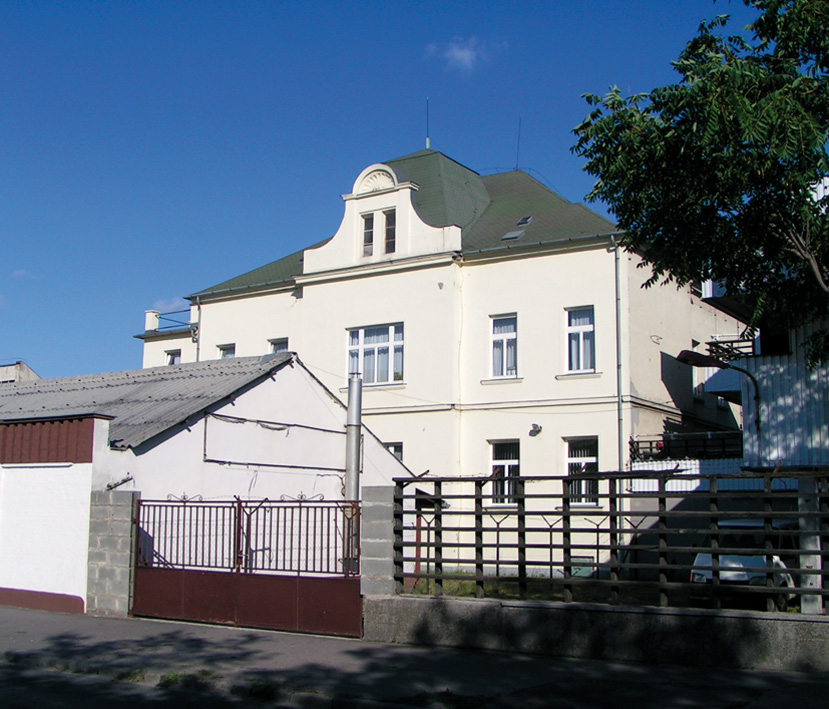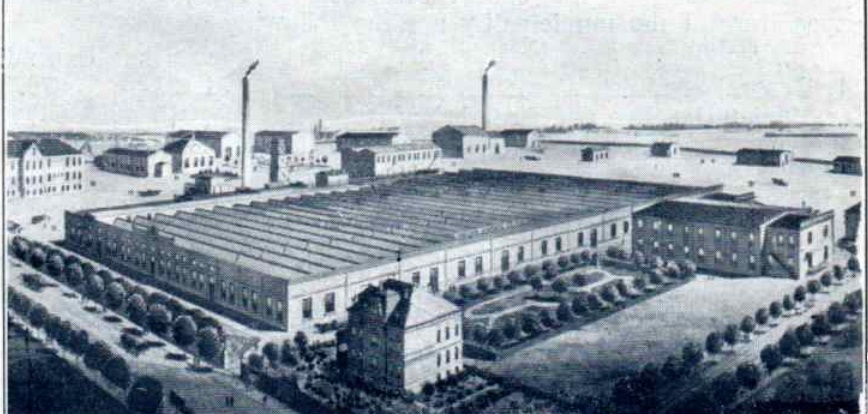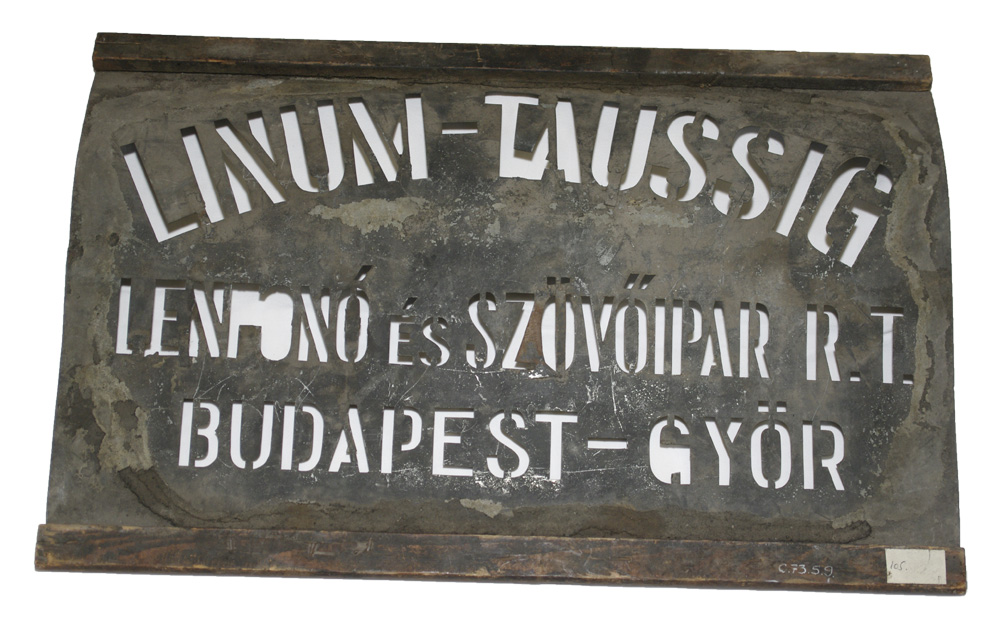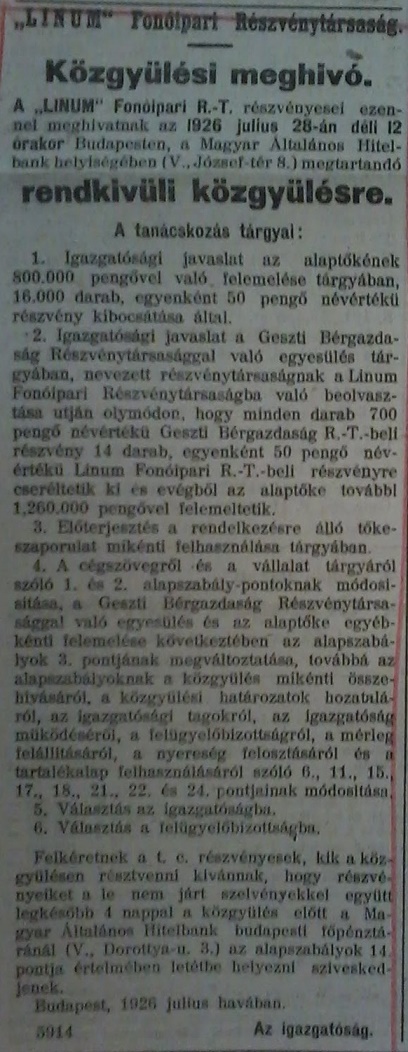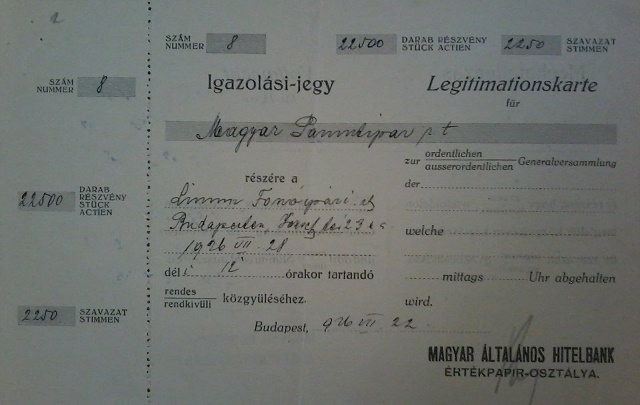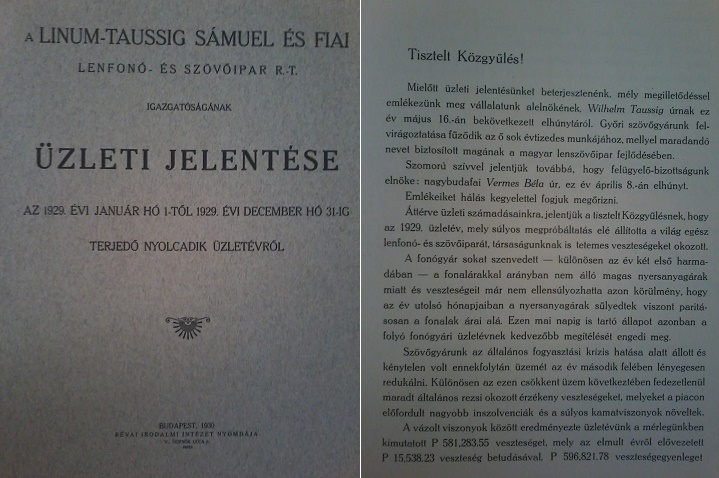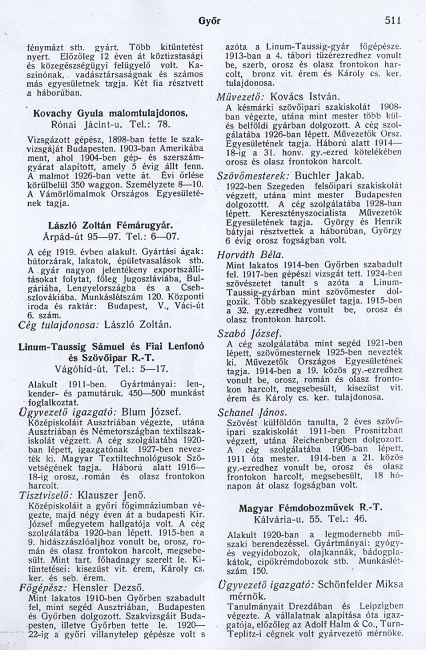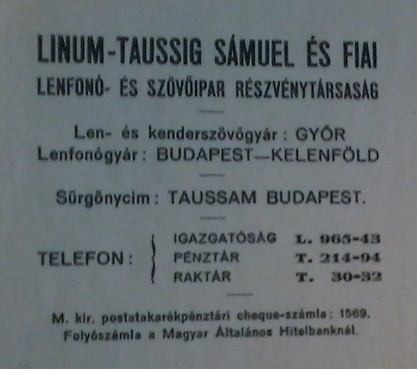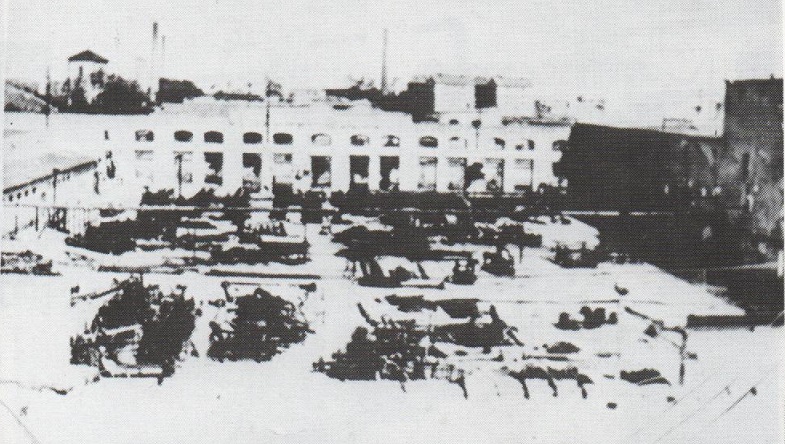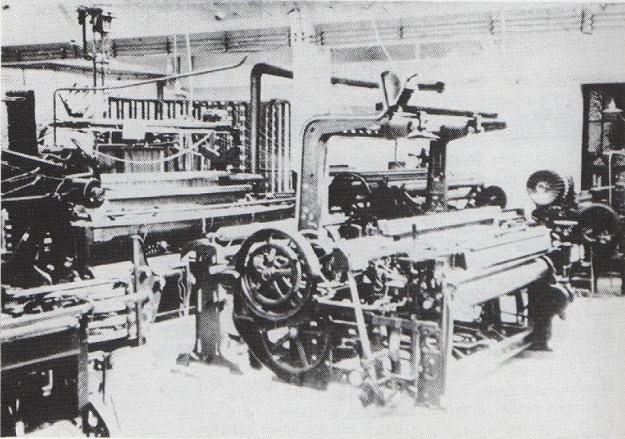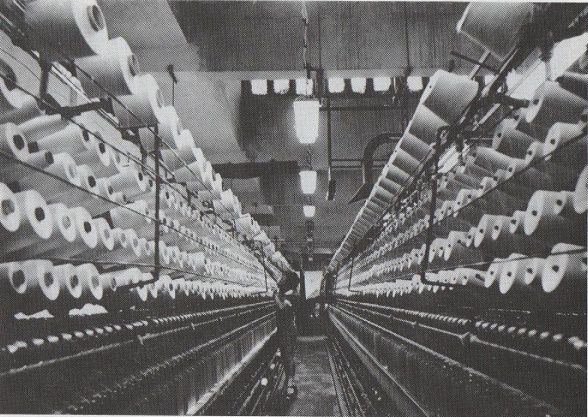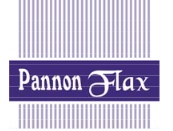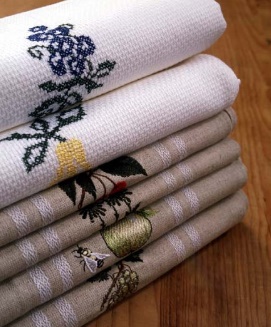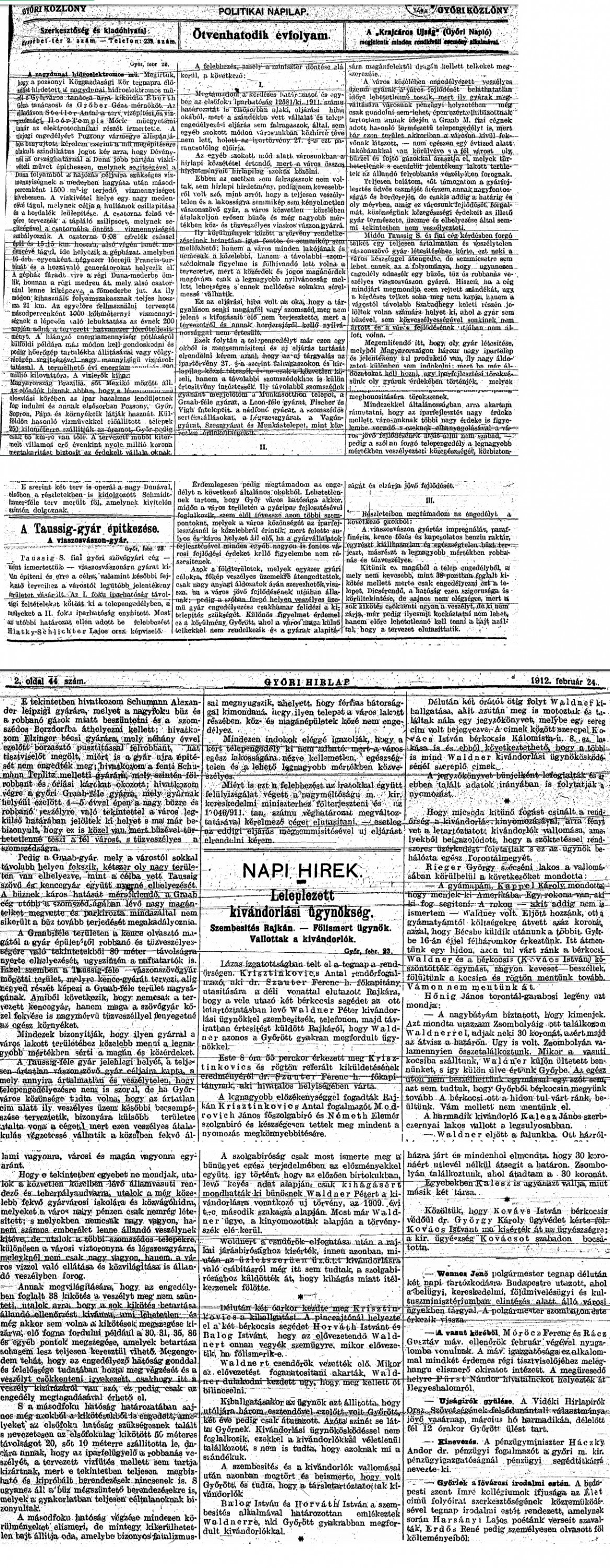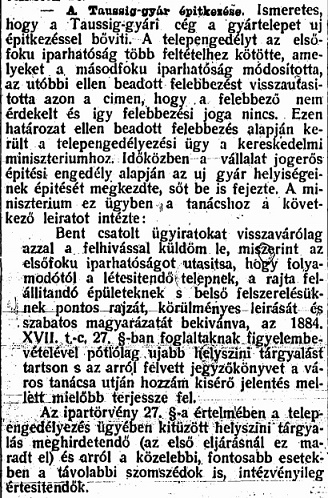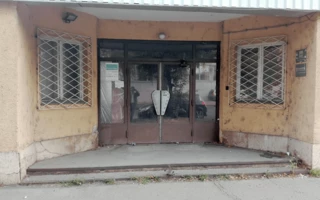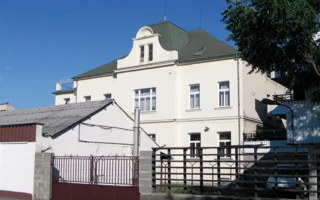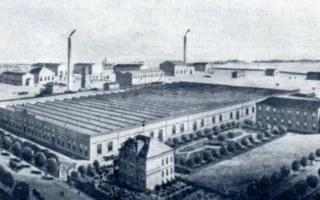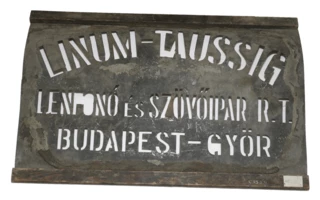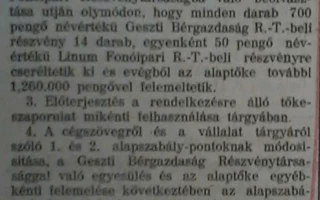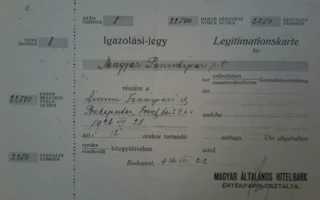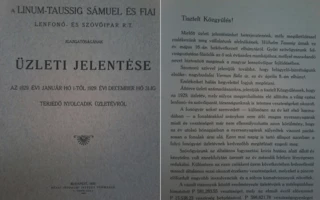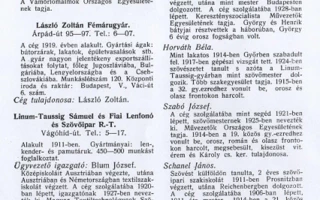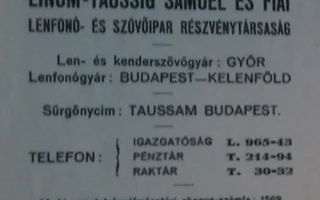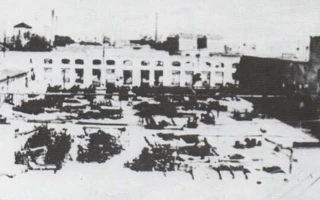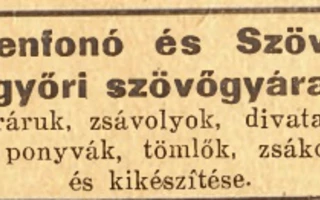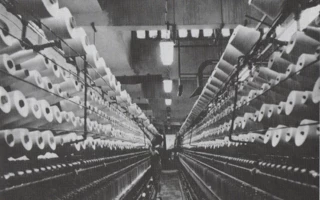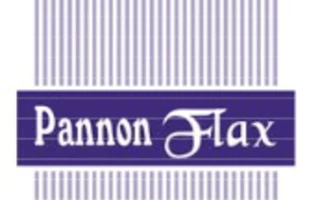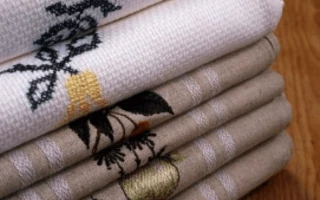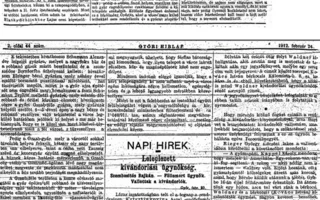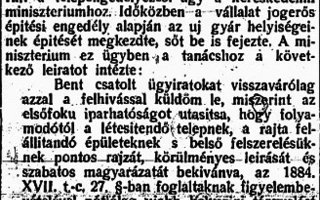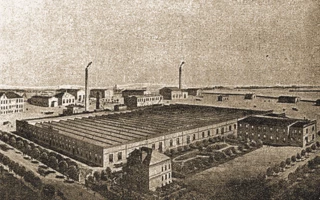Contact details
Foundation for Industrial History of Győr
Szent István út 10/a
Phone:
+3696520274
Fax: +3696520291
E-mail:
ipartortenet@ipartortenet.hu
Map
Taussig Sámuel and Sons Mechanical Flax and Hemp Weaving, Finishing and Impregnating Factory
| ADRESS OF THE MEMORIAL SITE, ROUTE PLANNING |
| WHAT CAN WE SEE AT THE MEMORIAL SITE? |
The memorial plaque is located on the wall of the factory's entrance building at 3 Kandó Kálmán Street .
The site, which has been partially empty for years and is in a dilapidated state, is hidden from onlookers by a high fence all around. On the Kandó Street side, the classic company sign above the entrance and the iron gate of the freight yard are still visible.
The main entrance of Pannonflax on Kandó Street (Photo: Zsolt Andorka 2018)
On the corner of Kandó and Vágóhíd Streets, we can already find a new building, but if you look behind it, you can still see the beautiful green-roofed office building of the Taussig factory, even with the crumbling plaster. From the Vágóhíd Street side, you can discover the row of skylights on the roof of the old factory building with a sawtooth arrangement, which was typical at the turn of the century.
The former office building of Taussig on the corner of Kandó and Vágóhíd streets (Photo: Zsolt Andorka 2007)
Street View:
-
| BRIEF OVERVIEW |
|
In January 1909, Sámuel Taussig notified the mayor of Győr that he wanted to establish a factory in the city. Production in the factory began on March 1, 1911. Since the owner fulfilled the conditions stipulated in the agreement with the city, he received the discounts included in it. When the Taussig family's 15-year Győr discount expired, they sold their factory to the Budapest-based Linum Fonóipari Rt. for 2 million pengő. During World War II, the factory suffered serious damage. After the war, the factory, which changed its name to Győri Szövőgyár, was nationalized, and then in 1963 it continued to operate as one of the factory units of BUDA-FLAX Lenfonó- és Szövőipari Vállalat, which brought together five flax industry companies in the country. In 1988, the factory was transformed into a joint-stock company under the name BUDA-FLAX Győri Lenszövő Rt. After the transition difficulties, successful operation followed, which was also noticed by foreign investors. Later, the share capital was increased several times and the ownership structure changed in connection with this. The company changed its name to Pannon-Flax Győri Lenszövő Rt. on November 24, 1994. In 2000, they launched a development program worth several hundred million forints, within the framework of which their jacquard weaving machines were converted to the production of household textiles and the weaving plant was modernized. The company operated as a public joint-stock company from July 26, 2006. The company's main activities were investment, real estate development, and the weaving, finishing, confectioning and distribution of cotton and linen fabrics. After the successful years, a period of crisis followed. The purchase prices of raw materials continuously increased, and energy prices increased drastically. From 1 January 2009, Pannon-Flax Plc. was primarily engaged in investment and real estate development activities. The textile industry activities were outsourced to an independent subsidiary called Pannonflax Textil Kft. Their products were produced exclusively from natural raw materials, primarily flax and cotton. Bankruptcy proceedings began on 31 May 2013. According to economic experts, it is a miracle that a Hungarian textile company was able to compete until 2013 against cheap Far Eastern imports that were crushing everything. |
| DETAILED HISTORY |
On January 11, 1909, Sámuel Taussig notified the mayor of Győr, Jenő Wennes, that he wanted to establish a factory in the city. Since the owner had fulfilled the conditions stipulated in the agreement with the city, he received the benefits included therein, i.e. 8 cadastral acres of land for free, exemption from paying city taxes, bridge and paving duties, and the right to use the siding for free. Production in the factory began on March 1, 1911, on 160 mechanical weaving machines, with 150 employees. The owners applied to the city for the establishment of another factory that same year. The construction contractor, MP Lajos Hlatky-Schlichter – the contractor of the existing factory halls and office building – tried to prevent the plan to build the oilcloth factory, citing the risk of fire and explosion.
Source: Free Royal City and County of Győr. Budapest, 1926. p. 20.
When the Taussig family's 15-year Győr concession expired, they sold their factory to the Budapest-based Linum Fonóipari Rt. for 2 million pengő and additional benefits. On July 9, 1926, according to the resolution of the general meeting that merged the two companies, the company's name became Linum – Taussig Sámuel és Fiai Lenfonó- és Szövőipari RT.
Linum-Taussig painting stencil
(From the collection of the Rómer Flóris Museum of Art and History. Photo: Zsolt Andorka)
Invitation to the General Assembly published in the July 13, 1926 issue of the Budapest Gazette Official Bulletin
Source: MNL Győr-Moson-Sopron County Archives of Győr
Share certificate issued to the Hungarian Cotton Industry Co. Ltd. for the general meeting of Linum Spinning Industry Co. Ltd. to be held on July 28, 1926.
Source: MNL Győr-Moson-Sopron County Archives of Győr
The global economic crisis that broke out in 1929 also negatively affected the company's operations. In addition to the low level of yarn prices, raw material prices rose significantly. Due to the general consumer crisis, production had to be reduced.
The introduction to the business report for 1929, published in 1930, announces the death of Vilmos Taussig.
Source: MNL Győr-Moson-Sopron County Archives of Győr
Detailed description and monograph of the administratively united counties of Győr-Moson-Pozsony and the city of Győr with legal force and royal title for the years 1929–1930. Editor-in-chief Sámuel Kerekes, editor Barnabás Enyedy. 1930. p. 511.
Letterhead from a document dated 1932
Source: MNL Győr-Moson-Sopron County Archives of Győr
After years of losses, the company's recovery was indirectly due to the Darányi program . The development program announced in Győr provided the financial resources needed for weapons production for heavy industry and the mechanical engineering industry, but the constantly increasing number of Hungarian army personnel also affected the textile industry. In 1939, the company's Győr weaving mill produced fabrics made from flax, hemp, wool and synthetic fibers. 30–40% of the production went to the defense forces.
The company changed its name to Linum Lenfonó- és Szövőipari Rt in June 1940 , after the Taussig family ceased all official ties with the joint-stock company.
During World War II, the plant suffered severe damage.
Burnt-out building in Szövöde in 1944
After the war, the factory gets its evacuated machines back, and most of the workers are still working on clearing the rubble and rebuilding when temporary production starts.
Weaving machine rebuilt and put into operation in 1945
Advertisement. Directory of the authorities and offices of the city of Győr for the year 1947. Győr, 1947
After nationalization , the textile factory operated under a new name, the Győr Weaving Factory of the Transdanubian Flax Company. In 1963, the country's five flax companies were merged, and the Győr factory continued to operate as a unit of the BUDA-FLAX Flax Spinning and Weaving Company.
Threader, 1980s
In October 1988, the factory was transformed into a joint-stock company under the name BUDA-FLAX Győri Lenszövő Rt. The initial problems of the transition were resolved in a short time, and the successful operation was also noticed by foreign investors. In 1991, a German investor together with Erste Österreichische Sparkasse Bank acquired 3/4 of the shares. Later, the share capital was increased several times and the ownership structure also changed in connection with this. The company changed its name to Pannon-Flax Győri Lenszövő Rt . on November 24, 1994 .
In 1996, they purchased the Lőrinci Fonoda, which completed the production vertical. Orders from the armed forces decreased significantly in 1998, but indirect costs increased. In the hope of standing on more legs, the company purchased 100% of the shares of Betonútépítő Nemzető Építőipari Rt. In 2001, Pannon-Flax Győri Lenszövő Rt. closed with a consolidated after-tax loss of several billion HUF, which was caused by the bankruptcy of Betonútépítő, which they owned, and which they soon sold.
The Győr-based joint-stock company with a share capital of HUF 440 million acquired a 20% ownership stake in Eurodomb Ingatlanfejlesztési Kft. In 2000, they launched a development program worth several hundred million HUF , within the framework of which their jacquard weaving machines were converted to the production of household textiles, the weaving plant was modernized, and the Soviet weaving machines from the Methuselah era were replaced with new German machines. Pannon-Flax Győri Lenszövő Rt. achieved an after-tax profit of HUF 140 million in 2000. In 2003, one of their products won the Hungarian Product Grand Prix and another the Hungarian House of Quality Award.
The four-color camouflage jacket and trousers developed for military purposes received the Hungarian Product Grand Prix in 2005.
Pannon-Flax Győri Lenszövő Rt. operated as a public limited company from July 26, 2006. The company's main activities are investment, real estate development, and the weaving, finishing, confectioning and distribution of cotton and linen fabrics. After the successful years, a crisis period followed. From 2007, the purchase prices of raw materials and energy prices increased drastically. This was partially mitigated by more favorable individual contracts and the use of energy-saving technologies, but even this could not offset the drop in the value of American orders by 1/3. In the interests of efficiency, the Company improved the efficiency of live labor, the quality of products, and in order to reduce costs, they installed machines on a smaller area and developed products, and acquired new markets.
Tablecloths
In order to stand on more legs, Pannon-Flax Győri Lenszövő Nyrt. founded smaller companies (Dawnmount Hungary Kft., B+G Kft., Flaxtrade Trading and Service Kft., Maxima Trading and Service Kft.) in Budapest and Győr, which dealt with real estate sales, leasing, workwear production and distribution. The enterprises majority-owned by the parent company did not bring the expected results, and the accumulating losses were finally eliminated by liquidating the Kft.s. From 1 January 2009, Pannon-Flax Nyrt. primarily dealt with investment and real estate development activities. The textile industry activities were outsourced to an independent subsidiary.
Product samples
Pannonflax Textil Kft., which is 100% owned by the parent company, Pannon-Flax Győri Lenszövő Nyrt., started its operations in January 2009 under the leadership of Gézán Teimel. Their products were produced exclusively from natural raw materials, primarily flax and cotton. Their main activity: weaving, finishing, confectioning and distribution of cotton and linen fabrics. They produced and distributed household and home textiles, work and protective clothing products, training clothing materials, flax-type clothing fabrics, technical fabrics, lining materials, clothing accessory fabrics.
Product samples
Pannonflax Textil Kft. generated a profit of 27 million forints in 2009, but the following year they recorded a loss of 141 million forints. On May 31, 2013, bankruptcy proceedings became inevitable . According to economic experts, it is a miracle that a Hungarian textile company was able to compete with cheap Far Eastern imports that were crushing everything until 2013.
The bankruptcy, according to the chairman of the board, Ernő Váradi, was caused by the fact that, despite successful exports, domestic, mainly public sector orders, which accounted for half of the company's revenue, were not received. The main customers (the Ministry of the Interior, MÁV and Magyar Posta) chose Hungarian clothing companies working with foreign raw materials in 2013. If the public sector orders, which account for 95% of the company's domestic revenue, were to be lost, the company's collapse would be inevitable, resulting in the loss of 170 employees and 120 subcontractors' jobs and the loss of vocational training in the Hungarian textile industry.
The compilation was based on the study by Mrs. Orbánné Dr. Márta Horváth and the book by János Füstös-Sándor Lónyai: The 75th Anniversary of the Győr Weaving Factory of the BUDA-FLAX Linen and Weaving Industry Company.
| INTERESTING FACTS |
|
The appeal submitted by Lajos Hlatky-Schlichter, a member of parliament, to the Minister of Trade regarding the construction of the waxed linen factory to be established can be read in its entirety in the February 24, 1912 issue of the Győri Hírlap under the title Construction of the Taussig factory. The waxed linen factory. Győri Hírlap, February 24, 1912, No. 44, pp. 1-2. The Minister of Trade's response to the submission of Lajos Hlatky-Schlichter regarding the construction of the waxed linen factory. Győri Hírlap, August 11, 1912, issue 183, page 6. |
|
Name variations: Taussig Sámuel and Sons Mechanical Flax and Hemp Weaving, Finishing and Impregnating Factory 1911– Linum-Taussig Sámuel and Sons Linen Spinning and Weaving Co. 1926– Linum Flax Spinning and Weaving Co. 1940– Győr Weaving Factory 1948– Transdanubian Linen Industry National Company 1950– Győr Weaving Factory of the Flax Spinning and Weaving Company (BUDA-FLAX) 1963– Buda-Flax Győri Lensweaving Co. 1988– Pannon-Flax Győri Lensweaving Co. 1994– PannonFlax Győri Lens Fiber Plc. 2006– |
| LITERATURE |
- 1986. János Füstös-Sándor Lónyai: The story of the 75th anniversary of the Győr Weaving Factory of the BUDA-FLAX Flax Spinning and Weaving Company. Publ. Flax Spinning and Weaving Company, Budakalász, Szikra Nyomda, Pécs. 165 pages.
- 2005. PANNON-FLAX Győri Lenszövő Rt. report for the year 2004
https://bet.hu/newkibdata/111657/11657_1_PFL050428AR01H.pdf - 2014. Orbánné Márta Horváth: The transformation of the textile industry in Győr from 1985 to the present day. In: From the imperial and royal privileged mechanical flax and jute factory to the Pannon Flax Public Limited Company. In. The driving forces of the development of Győr. The Győr automotive industry district as a new direction and tool for regional development. Research monographs 1. Győr, Palatia Nyomda. 159-161. pp.
Image source:
- product samples: PANNON-FLAX Győri Lenszövő Rt. report for the year 2004
- Contemporary photographs: János Füstös-Sándor Lónyai: The story of the 75th anniversary of the Győr Weaving Factory of the BUDA-FLAX Flax Spinning and Weaving Company.
document copies: MNL Győr-Moson-Sopron County Győr Archives Linum-Taussig S. and Sons Linen Spinning and Weaving Co. (1922-48/50) documents (XI.8.)

Related gallery
Back to the previous page!
